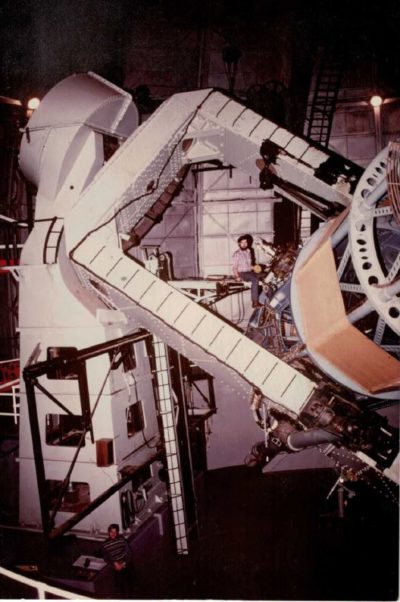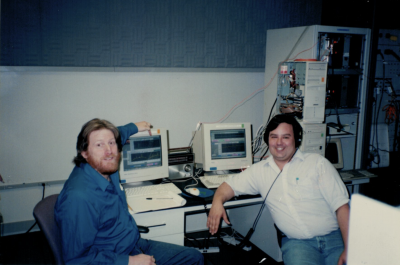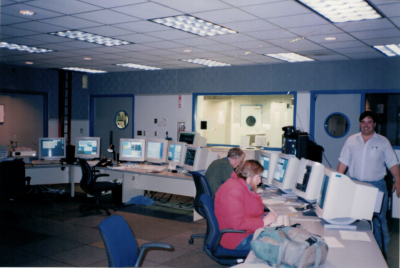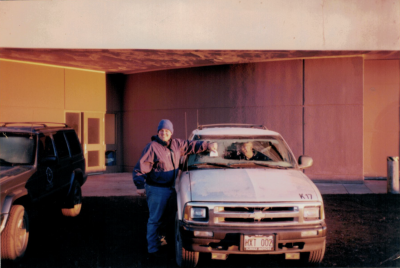Exotic Star Binaries
Not all stars shine with a constant light– some stars can double in brightness in a few seconds, and increase in brightness by a factor of a hundred within a few hours. These stars are accreting binary systems, where a compact object such as a white dwarf, neutron star, or black hole is in a close orbit with an ordinary star. The two stars are almost touching, and the orbital periods can be as little as 11 minutes. The gravitational field of the compact object pulls gas off the surface of the ordinary star, and this gas spirals around the compact object to form an accretion disk, and then slams onto its surface. Rather than flowing in an even stream, the gas comes off the surface of the donor star in irregular chunks. As each chunk hits the disk of gas spiraling in to the compact object, the collision heats the gas and causes a burst of X-rays and light. Blobs of gas from the inner edge of the accretion disk similarly slam on to the surface of the compact object and cause a flash of X-rays and light.
In a collaboration with Dr. Keith Horne that began several years ago when we were freshmen in college, I designed and built detectors and data systems to study rapidly varying light from stars. Some of the systems I built were:
- a millisecond photometer for use on small telescopes
- a millisecond photometer for use on the 60″ and 100″ telescopes at Mount Wilson, the 60″ at Palomar, and the 100″ at Las Campanas
- a data link between Steve Shectman’s Shectograph on the 100″ at Mt. Wilson and the 60″ at Mt. Wilson, allowing us to do exact simultaneous spectroscopy and photometry with the two telescopes.
- a high speed datasystem for Steve Shectman’s 2D-Fruitti spectrometer. This allowed us to do continuous millisecond spectroscopy of the black hole binary A0260-00 with the 200″ at Palomar, and similar work with the 100″ at Las Campanas.
- a datasystem for the LRIS spectrograph at the 10 meter Keck telescope on Mauna Kea, allowing us to take 14 spectra per second continuously, with coordinated observations using the Rossi XTE X-ray satellite.
With these data systems, we found a wealth of unexpected phenomena. For instance, in AE Aquarii, we found that the rapidly rotating magnetic field from the spinning white dwarf acts a propeller, spraying gas out of the system.

Keith Horne and me at the Mount Wilson 100″ setting up for high-speed photometry. I’m on the diving board by the photomultiplier (I had a beard at the time); Keith is by the bottom of the ladder, about to head down to the data room. On the diving board, there was no seatbelt or safety harness; aligning the star in the pinhole, guiding the scope, and moving the diving board out of the way of the telescope in the dark required full concentration…. Then changing to a new object with the dome rotating (quite disorienting) and the scope moving in slew mode was exciting – you had to be familiar with the diving board control paddle to move the diving board quickly enough to not get your legs caught between the scope and board. Larry Webster took this photo.

Keith Horne and me with my high speed spectroscopy datasystems at the Keck telescope. I designed and built two datasystems, both recording the data and showing different aspects of the real-time analysis. The technical challenges involved unobtrusively tapping a fiberoptics cable, and dealing with the very poor cooling at 14,000 feet. Because we were doing simultaneous observations with the Rossi XTE X-ray satellite, the radio was used to check the WWV timesignals used for the coordination.

Bev Oke, Keith Horne, and me in the Keck data room; the XTE satellite can bounce data to a TDRSS satellite, then down to Goddard, then to us on the mountain in Hawaii. allowing us to watch the X-ray spectrum as we monitor the optical spectrum of a cataclysmic variable.

Hawaii in July, I’m scraping ice off the windshield; Bev is in the car.
Papers
Skidmore, W., Gomer, R.H, Horne, K., O’Brien, K., Oke,.B. and Pearson, K.J. High Speed Keck Spectroscopy of Flickering in AM Her. IAU Colloquium 190 on Magnetic Cataclysmic Variables: ASP Conference Series, 315, 163-169 (2004).
O’Brien, K., Horne, K, Gomer, R.H., Oke, J.B., and van der Klis, M. High-speed Keck II and RXTE spectroscopy of Cygnus X-2: (I) Three X-ray components revealed by spectral variability. Monthly Notices of the Royal Astronomical Society. 350, 587-595. (2003).
Skidmore, W., O’Brien, K., Horne, K., Gomer, R.H., Oke, J.B., and Pearson, K.J. High speed Keck spectroscopy of flares and oscillations in AE Aquarii. Monthly Notices of the Royal Astronomical Society 338, 1057-1066 (2003).
Skidmore, W., Pearson, K.J., O’Brien, K., Horne, K., and Gomer, R. Fireballs and oscillations in AE Aqr., The Physics of Cataclysmic Variables and Related Objects: ASP Conference Series 261, 169-170 (2002).
O’Brien, K., Horne, K., Boroson, B., Still, M., Gomer, R., Oke, J.B., Boyd, P., and Vrtilek, S.D. Keck II spectroscopy of mHz quasi-periodic oscillations in Hercules X-1. Monthly Notices of the Royal Astronomical Society 326, 1067-1075 (2001).
Steeghs, D., O’Brien, K., Horne, K., Gomer, R., and Oke, B. Emission line oscillations in the dwarf nova V2051 Ophiuchi. Monthly Notices of the Royal Astronomical Society 323, 484-496 (2001).
Bloom, J.S., Frail, D.A., Kulkarni, S.R., Djorgovski, S.G., Halpern, J.P., Marzke, R.O., Patton, D.R., Oke, J.B., Horne, K.D., Gomer, R., Goodrich, R., Campbell, R., Moriarty-Schieven, F.H., Redman, R.O., Feldman, P.A., Costa, E., Masetti, N. The discovery and broad-band follow-up of the transient afterglow of GRB 980703. Astrophysical Journal 508, L21-L24 (1998).
Welsh, W.F., Horne, K., and Gomer, R.H. Doppler signatures of Hα flares in AE Aquarii. Monthly Notices of the Royal Astronomical Society 298, 285-302 (1998).
Welsh, W.F., Horne, K., and Gomer, R. Flares and flickering in the cataclysmic variable AE Aquarii. Lecture Notes in Physics 454, 278-279 (1995).
Welsh, W.F., Horne, K., and Gomer, R. A study of the absorption lines from the donor star in the exotic cataclysmic variable AE Aquarii. Monthly Notices of the Royal Astronomical Society 275, 649-670 (1995).
Martell, P.J., Horne, K., Price, C.M., and Gomer, R.H. Taking the pulse of DQ Herculis. Astrophysical Journal 448, 380-394 (1995).
Welsh, W.F., Horne, K., and Gomer, R. On the location of the oscillations in AE Aquarii. Astrophysical Journal 410, L39-L42 (1993).
Jensen, K.A., Cordova, F.A., Middleditch, J., Mason, K.O., Grauer, A.D., Horne, K., and Gomer, R. The correlated X-ray and optical time variability of TT Arietis. Astrophysical Journal 270, 211-225 (1983).
Horne, K., Lanning, H.H., and Gomer, R. A first look at the cataclysmic variable Lanning 10. Astrophysical Journal 252, 681-689 (1982).
Petro, L.D., Bradt, H.V., Kelley, R.L., Horne, K., and Gomer, R. Rapid X-ray and optical flares from Scorpius X-1. Astrophysical Journal 251, L7-L11 (1981).
Horne, K., and Gomer, R. Phase variability in the rapid oscillation of SS Cygni. Astrophysical Journal 237, 845-849 (1980).
